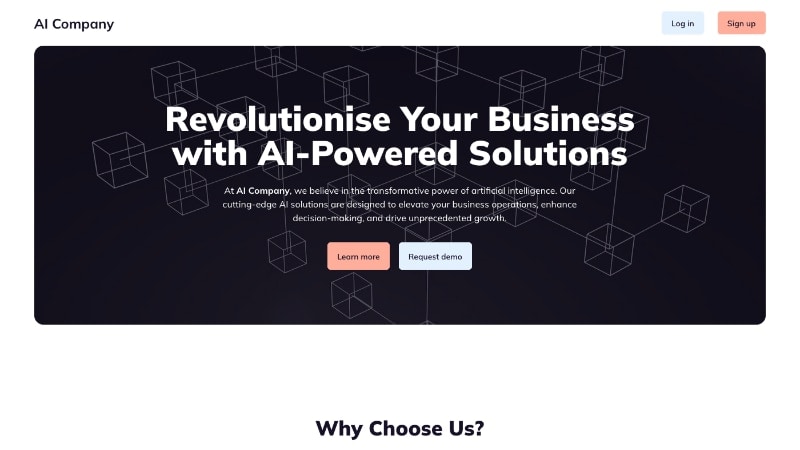
Astro on Netlify Platform Starter
A modern starter based on Astro.js, Tailwind, daisyUI, and Netlify Core Primitives.
Live demo Source codeJamstack has revolutionized the way we think about building for the web by providing a simpler developer experience, better performance, lower cost and greater scalability.
This simple guide will help you understand why it exists and how to get started.
Try Jamstack now. Create a new site with these templates in a few minutes on Netlify.

A modern starter based on Astro.js, Tailwind, daisyUI, and Netlify Core Primitives.
Live demo Source code
Modern starter based on Astro.js, Tailwind, daisyUI, and Sanity CMS.
Live demo Source code
Dante, a single-author blog and portfolio template for Astro.js.
Live demo Source code
An Astro + Tailwind CSS template for landing pages.
Live demo Source code"Jamstack" was originally cased as "JAMstack" where "JAM" stood for JavaScript, API & Markup.
"A modern web development architecture based on client-side JavaScript, reusable APIs, and prebuilt Markup"— Mathias Biilmann (CEO & Co-founder of Netlify).
Dynamic functionalities are handled by JavaScript. There is no restriction on which framework or library you must use.
Server side operations are abstracted into reusable APIs and accessed over HTTPS with JavaScript. These can be third party services or your custom function.
Websites are served as static HTML files. These can be generated from source files, such as Markdown, using a Static Site Generator.
Today, Jamstack is used to more broadly refer to an architectural approach for building websites. Though there are varying opinions on what exactly Jamstack means today, these attributes are present in most sites that claim to be Jamstack sites:
The front end uses tooling separate from the back end. The front end is typically built using a static site generator. And the back end is often integrated with the front through the use of APIs used during the build process. Server-side processes can also be run using serverless functions.
While various practices exist for introducing dynamic elements to Jamstack sites, most are pre-rendered, which means the front end was built and compiled into HTML, CSS, and JavaScript files.
JavaScript can be introduced to pre-rendered sites on an as-needed basis, thus increasing performance in the browser.
Here are the main benefits provided by the Jamstack.
Serve pre-built markup and assets over a CDN.
No need to worry about server or database vulnerabilities.
Hosting of static files is cheap or even free.
Front end developers can focus on the front end, without being tied to a monolithic architecture. This usually means quicker and more focused development.
If your product suddenly goes viral and has many active users, the CDN seamlessly compensates.
The following tips will help you leverage the best out of the stack.
Since all the markup and assets are pre-built, they can be served via CDN. This provides better performance and easier scalability.
Learn moreEach deploy is a full snapshot of the site. This helps guarantee a consistent version of the site globally.
Learn moreOnce your build is uploaded, the CDN invalidates its cache. This means that your new build is live in an instant.
Learn moreYour codebase lives in version control system, such as Git. The main benefits are changing the history of every file, collaborators and traceability.
Learn moreYour server is notified when a new build is required, typically via webhooks. Server builds the project, updates the CDNs and the site is live.
Learn moreHere's an ideal Jamstack workflow:
A brief history of Jamstack shows its growth in popularity.
However you decide to generate your HTML assets is up to you. The three most common approaches are:
Simple and effective method of writing HTML, it's ideal for super simple pages.
Most Jamstack sites are powered by a modern web frameworks.
Tools that bring Jamstack to less technical users, while enabling developers to customize sites through modern tooling.
Your built site needs to be hosted somewhere. There are great services that provide this for free and with ease.
Jamstack websites don't have to be static. There are great services available to help bring some dynamic data to your product.
You can also abstract your own functions into reusable APIs.
As you add features to your site, you may want to store user profiles, shopping cart data, game levels, or other dynamic data. There are many DBaaS (database as a service) tools out there today.
Many Jamstack products have dynamic comment sections. These are typically used on blogs.
A great way to interact with your audience. Tools like Netlify support this by default, though there are other form-based services.
Setting up an online store on the Jamstack has never been easier.
Rely on third party services to integrate a search functionality.
Jamstack sites can also be controlled via a Content Management System, these are typically known as Headless CMS. Once a change in the CMS is made, a new build of your site will be triggered and then deployed as static assets.
Here's a list of hand-picked Jamstack resources ranging from learning materials to third party services.
This project was originally built by @peduarte and presented at the Jamstack meetup in London. The project is supported by Netlify.
The goal of this project is to gather the concept of Jamstack in a straight-forward way to encourage other developers to adopt the workflow.
Built with the help of Astro, Tailwind CSS, Netlify, and GitHub.
Jamstack.